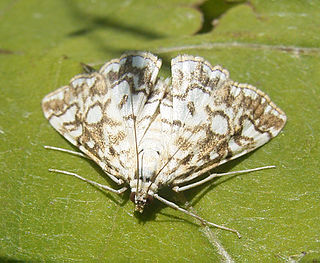Manoba is a genus of moths in the family Nolidae. The genus was first described by Francis Walker in 1863.

Trichromia is a genus of arctiine tussock moths in the family Erebidae. The members of this genus are largely indigenous to South America.

Ancylolomia is a genus of moths of the family Crambidae described by Jacob Hübner in 1825.
Classeya is a genus of moths of the family Crambidae.
Hendecasis is a genus of moths of the family Crambidae described by George Hampson in 1896.

Palpita is a genus of moths of the family Crambidae. Members of the moth genus Stemorrhages may be very similar in appearance.

Scoparia is a grass moth genus of subfamily Scopariinae. Some authors have assigned the synonymous taxon Sineudonia to the snout moth family (Pyralidae), where all grass moths were once also included, but this seems to be in error.
Phalacra is a genus of moths belonging to the subfamily Drepaninae. The genus was erected by Francis Walker in 1866.
Spectroreta is a monotypic moth genus belonging to subfamily Drepaninae erected by Warren in 1903. Its only species, Spectroreta hyalodisca, was described by George Hampson in 1896.

Tridrepana is a genus of moths belonging to the subfamily Drepaninae.

Lamoria is a genus of small moths belonging to the family Pyralidae.

Macalla is a genus of snout moths. It was described by Francis Walker in 1859.

Acentropinae is a fairly small subfamily of the lepidopteran family Crambidae, the crambid snout moths. Species of this subfamily are exclusively found in wetlands and aquatic habitats.

Manoba tesselata is a moth in the family Nolidae. It was described by George Hampson in 1896. It is found in Taiwan, as well as on Borneo, Sumatra, Java, Bali, Seram and the north-eastern Himalayas and in Thailand. The habitat consists of montane forests.
Diathraustodes leucotrigona is a moth in the family Crambidae. It was described by George Hampson in 1896. It is found in the Nilgiri Mountains of India and Silhouette Island in the Seychelles.
Pediasia ochristrigella is a moth in the family Crambidae. It was described by George Hampson in 1896. It is found in the Punjab of what was British India, western Pakistan, Tunisia and Sri Lanka.
Balaenifrons homopteridia is a moth in the family Crambidae. It was described by George Hampson in 1896. It is found in Myanmar, Bengal and northern Borneo.
Auchmophoba costastrigalis is a moth in the Crambidae family. It was described by George Hampson in 1896. It is found in Sri Lanka.
Gaurena is a genus of moths belonging to the subfamily Thyatirinae. It was erected by Francis Walker in 1865.










